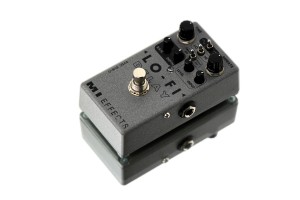MI Audio
NEW PROTOTYPE LO-FI DELAY
 Over the years, MI Effects has been known for great overdrive and distortion pedals and always have been asked “When will MI do a delay pedal?” There have been prototypes, and designs and ideas, but for the designs to come to fruition the pedal would have to retail for $1000, and no-one would pay that (would they?).
Over the years, MI Effects has been known for great overdrive and distortion pedals and always have been asked “When will MI do a delay pedal?” There have been prototypes, and designs and ideas, but for the designs to come to fruition the pedal would have to retail for $1000, and no-one would pay that (would they?).
But as of late, there have been a lot of manufacturers using the PT2399 chip; a digital delay that emulates an analog or tape delay sound. The PT2399 is a great value bundle in one IC, however it does have its limitations and these are apparent if you have played the current pedals in the market. So instead of trying to force this chip to be the replacement for your Echoplex, I decided to embrace these limitations and release a delay pedal that doesn’t quite fit into any category – yes it can do those classic modulated delays sounds (and very, very well too) but can be pushed to do so much more, and in turn, hopefully inspire some new sounds and experimentation.
So here it is: the (as-of-yet unnamed) MI Effects Lo-Fi Delay. A lot of careful design has gone into what goes around the PT chip to give modulation like no other pedal. There is control over the filtering of the delay signal that really gives a new perspective with a flick of the switch, and also the input and output of the pedal carefully honed to give you the control of the best signal-to-noise ratio.
The controls are:
- TIME – delay time up to a max of 600ms.
- REPEATS – go from short, slapback to self-oscillation. The LO-PASS/HI-PASS switch also affects how quickly the pedal will self-oscillate.
- RATE and DEPTH – these control the LFO modulation on the repeats. The RATE goes from super slow to throbbingly fast with a smooth taper for all speeds in between. The Depth also goes from zero at minimum for unmodulated delay, to super warble at maximum. There are some cool octave skipping sounds to be had in square wave mode.
- SQUARE/TRIANGLE WAVE – this switch selects the waveform of the LFO modulating the delay signal. Triangle wave at low rate and depth can give you classic chorus sounds, whilst square wave can give choppy, tremolo sounds, even pseudo pitch-shifting effects.
- LO/HI-PASS MODE – this switch controls the filtering of the delay line. The LO-PASS mode gives dark, analog repeats while the HI-PASS gives clarity to the top-end for shimmering modulation and self-oscillation. Using the LO-PASS mode “smears” the repeats together whilst the HI-PASS mode gives more defined repeats. The production will probably have a 3 position switch for three levels of filtering
- TRAILS ON/OFF – the trails switch allows the control of the trails continuing or cutting off once the pedal is turned off. This is extremely useful to not “cut-off” long delay lines allowing them to naturally decay if switched off mid-trail. Using trails on also allows you to play an atmospheric sound or oscillation, switch the pedal off and play over the top of it, acting almost like a short looper.
- LEVEL – this controls the LEVEL of wet, delay signal whilst having the dry signal constant. This is NOT a mix control.
- INPUT – this controls the INPUT gain of the signal hitting the circuit. This is provided to give you the best signal-to-noise ratio depending on what pickup/guitar/boosters you have in line. Start by setting the INPUT until it clips, then slightly back it off. Raise the LEVEL to taste and you have the clearest signal possible with the lowest floor noise. A bonus is that the INPUT gain can be set to max, and distort your delay line and keep the dry signal clean. This is perfect for stacking with other pedals and the overdrive channel of your amp.
Combining all of these features gives every guitarist, and instrumentalist, a whole new palette of sounds with something there for every guitarist. Modulation can go from subtle to extreme, or have pristine, clean repeats to distorted, washy, smeared reverb-like trails. Use the square wave for choppy, rhythmic pulses or triangle wave for classic chorus/vibrato. I encourage you to dig deeper and get inspired with some new sounds.